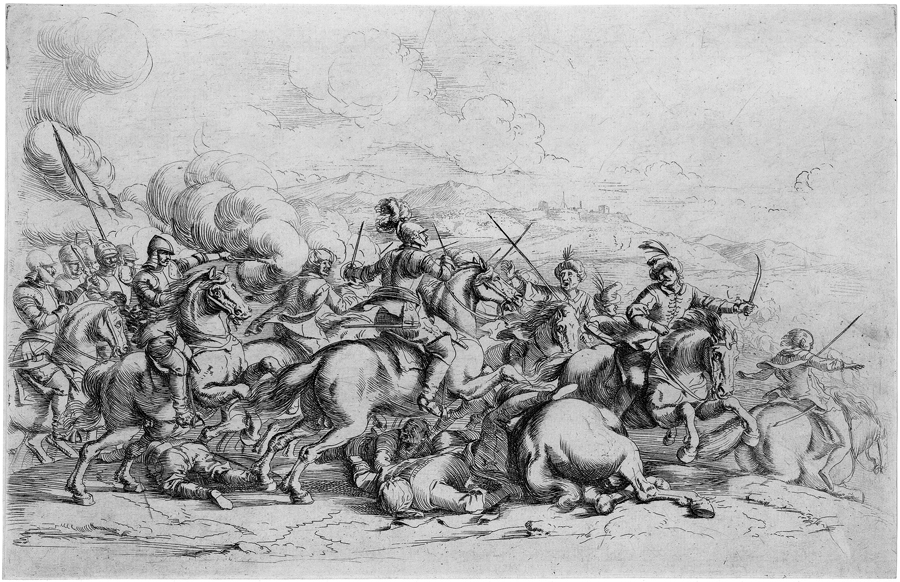Loading the page ...
Jacques Courtois
(called il Borgognone or Giacomo Borgognone delle Battaglie, 1621 Saint-Hippolyte – 1676 Rome)
Four Battle Scenes. Set of four etchings, each measuring approx. 21.1 x 33.3 cm. Robert-Dumesnil 9–12. Watermark: Fleur-de-Lis in circle (on R.-D. 11).
The French painter, etcher and draughtsman Jacques Courtois knew the smell of gun-powder and the horrors of the battlefield at first hand, having served as a young man with the Spanish army in Italy for three years. Courtois followed the fighting troops on their marches and in combat and faithfully documented what he saw with a wealth of detail in countless drawings. The experiences of these years were to be crucial to his later artistic career. He became one of the most celebrated battle painters of his time in Rome, where he arrived with his younger brother Guillaume around 1640. The artist led a varied and interesting life and travelled a great deal. Around 1636 Courtois spent some time in Milan and Bologna, where he attracted the attention of Guido Reni, studying under him and Francesco Albani. In Rome, in the circle of the Bamboccianti, he was inspired by Jan Asselijn and Michelangelo Cerquozzi and, following the latter’s advice, devoted himself thenceforth to battle painting. Pietro da Cortona, with whom he was on friendly terms, secured him his first commissions from the Roman patriciate.
Typical of Courtois’ painting is the objective, documentary character of his battle scenes. He does not deal with challenging themes from classical antiquity, such as Giulio Romano’s Battle of the Milvian Bridge, but realistically renders the clash of fighting men on the battlefields of his time. Spirited cavalry engagements are presented with virtuosity and panache. The two sides charge furiously at each other and, amid clouds of gun smoke, a bloody slaughter begins. Horses hurtle, mortally wounded, to the ground, crushing the bodies of the dead and wounded beneath them. And yet everything is presented in a sober, almost detached manner free of any moralizing undertones. The battle has all the appearance of a preordained and spectacular natural phenomenon.
A similarly lively and spontaneous treatment also distinguishes the present suite of four battle scenes. Courtois’ printed œuvre is not very extensive, amounting to just sixteen prints. The facility of the draughtmanship suggests that the scenes were probably sketched directly onto the copperplate without a preliminary drawing. Robert-Dumesnil drew attention to the extreme rarity of these prints as far back as 1835 in the first volume of his Peintre-Graveur Français.
Very fine, even impressions with narrow margins around the platemark. In perfect condition.
